Critical Analysis: Health and Socio-Political Issues in Aged Care
VerifiedAdded on 2023/06/11
|16
|4288
|342
Essay
AI Summary
This essay provides a comprehensive critique of consumer-directed care (CDC) in Australia, focusing on its health and socio-political dimensions. It examines the legal, ethical, political, and philosophical foundations of CDC, highlighting the principles of choice, flexibility, and autonomy. The analysis includes a discussion of the roles of key stakeholders such as the government, care providers, and consumers, and their involvement in the management and delivery of care services. The essay also critically discusses the collaborative nature of CDC, emphasizing the importance of partnership between consumers and providers, and the unique traits that make it suitable for the Australian context. The paper concludes by underscoring the benefits and challenges associated with consumer-directed care, including the need for clear rules of engagement and the impact of government policies on its implementation.

Running head: HEALTH AND SOCIO-POLITICAL ISSUES IN AGED CARE 1
Health and Socio-Political Issues in Aged Care
Student Name
Institution
Health and Socio-Political Issues in Aged Care
Student Name
Institution
Paraphrase This Document
Need a fresh take? Get an instant paraphrase of this document with our AI Paraphraser
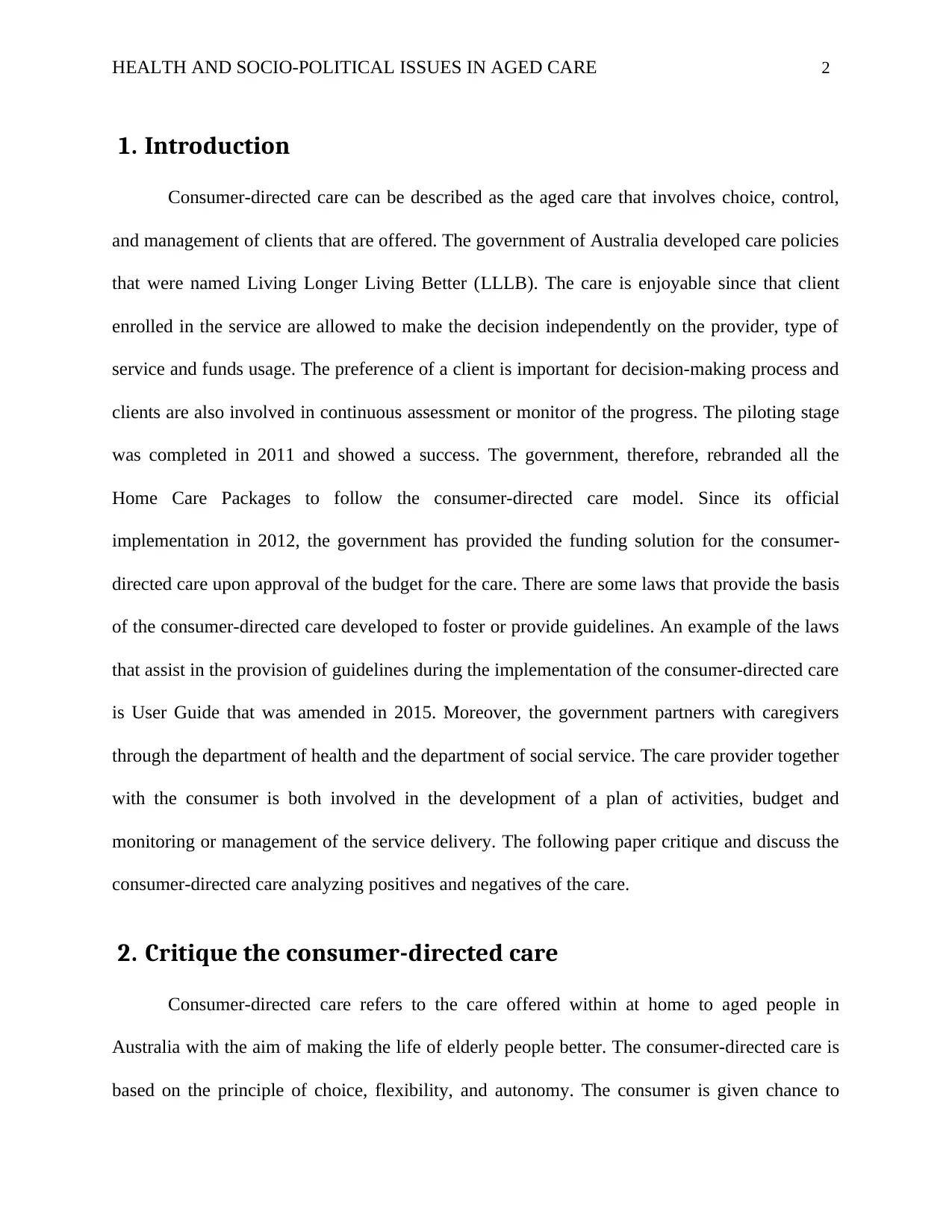
HEALTH AND SOCIO-POLITICAL ISSUES IN AGED CARE 2
1. Introduction
Consumer-directed care can be described as the aged care that involves choice, control,
and management of clients that are offered. The government of Australia developed care policies
that were named Living Longer Living Better (LLLB). The care is enjoyable since that client
enrolled in the service are allowed to make the decision independently on the provider, type of
service and funds usage. The preference of a client is important for decision-making process and
clients are also involved in continuous assessment or monitor of the progress. The piloting stage
was completed in 2011 and showed a success. The government, therefore, rebranded all the
Home Care Packages to follow the consumer-directed care model. Since its official
implementation in 2012, the government has provided the funding solution for the consumer-
directed care upon approval of the budget for the care. There are some laws that provide the basis
of the consumer-directed care developed to foster or provide guidelines. An example of the laws
that assist in the provision of guidelines during the implementation of the consumer-directed care
is User Guide that was amended in 2015. Moreover, the government partners with caregivers
through the department of health and the department of social service. The care provider together
with the consumer is both involved in the development of a plan of activities, budget and
monitoring or management of the service delivery. The following paper critique and discuss the
consumer-directed care analyzing positives and negatives of the care.
2. Critique the consumer-directed care
Consumer-directed care refers to the care offered within at home to aged people in
Australia with the aim of making the life of elderly people better. The consumer-directed care is
based on the principle of choice, flexibility, and autonomy. The consumer is given chance to
1. Introduction
Consumer-directed care can be described as the aged care that involves choice, control,
and management of clients that are offered. The government of Australia developed care policies
that were named Living Longer Living Better (LLLB). The care is enjoyable since that client
enrolled in the service are allowed to make the decision independently on the provider, type of
service and funds usage. The preference of a client is important for decision-making process and
clients are also involved in continuous assessment or monitor of the progress. The piloting stage
was completed in 2011 and showed a success. The government, therefore, rebranded all the
Home Care Packages to follow the consumer-directed care model. Since its official
implementation in 2012, the government has provided the funding solution for the consumer-
directed care upon approval of the budget for the care. There are some laws that provide the basis
of the consumer-directed care developed to foster or provide guidelines. An example of the laws
that assist in the provision of guidelines during the implementation of the consumer-directed care
is User Guide that was amended in 2015. Moreover, the government partners with caregivers
through the department of health and the department of social service. The care provider together
with the consumer is both involved in the development of a plan of activities, budget and
monitoring or management of the service delivery. The following paper critique and discuss the
consumer-directed care analyzing positives and negatives of the care.
2. Critique the consumer-directed care
Consumer-directed care refers to the care offered within at home to aged people in
Australia with the aim of making the life of elderly people better. The consumer-directed care is
based on the principle of choice, flexibility, and autonomy. The consumer is given chance to
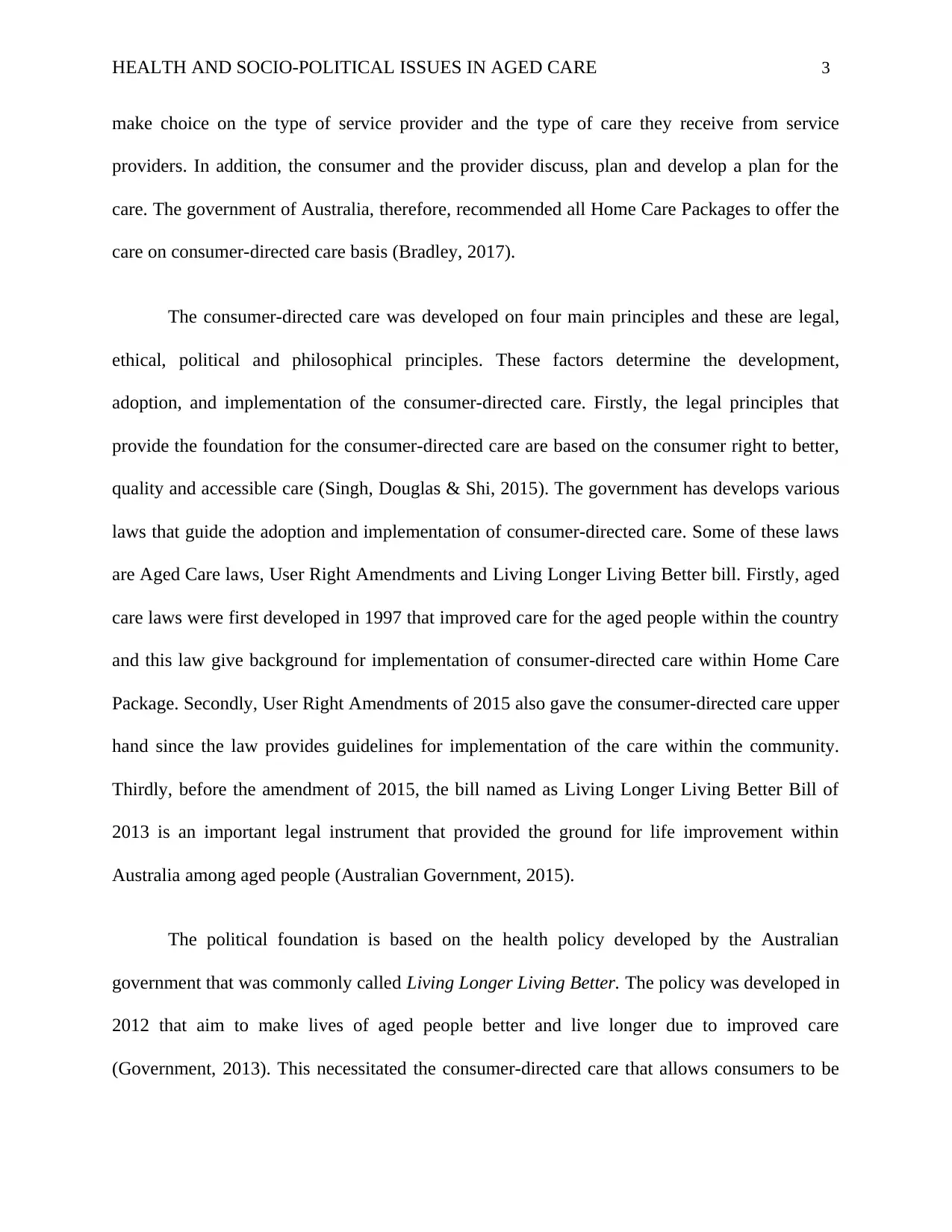
HEALTH AND SOCIO-POLITICAL ISSUES IN AGED CARE 3
make choice on the type of service provider and the type of care they receive from service
providers. In addition, the consumer and the provider discuss, plan and develop a plan for the
care. The government of Australia, therefore, recommended all Home Care Packages to offer the
care on consumer-directed care basis (Bradley, 2017).
The consumer-directed care was developed on four main principles and these are legal,
ethical, political and philosophical principles. These factors determine the development,
adoption, and implementation of the consumer-directed care. Firstly, the legal principles that
provide the foundation for the consumer-directed care are based on the consumer right to better,
quality and accessible care (Singh, Douglas & Shi, 2015). The government has develops various
laws that guide the adoption and implementation of consumer-directed care. Some of these laws
are Aged Care laws, User Right Amendments and Living Longer Living Better bill. Firstly, aged
care laws were first developed in 1997 that improved care for the aged people within the country
and this law give background for implementation of consumer-directed care within Home Care
Package. Secondly, User Right Amendments of 2015 also gave the consumer-directed care upper
hand since the law provides guidelines for implementation of the care within the community.
Thirdly, before the amendment of 2015, the bill named as Living Longer Living Better Bill of
2013 is an important legal instrument that provided the ground for life improvement within
Australia among aged people (Australian Government, 2015).
The political foundation is based on the health policy developed by the Australian
government that was commonly called Living Longer Living Better. The policy was developed in
2012 that aim to make lives of aged people better and live longer due to improved care
(Government, 2013). This necessitated the consumer-directed care that allows consumers to be
make choice on the type of service provider and the type of care they receive from service
providers. In addition, the consumer and the provider discuss, plan and develop a plan for the
care. The government of Australia, therefore, recommended all Home Care Packages to offer the
care on consumer-directed care basis (Bradley, 2017).
The consumer-directed care was developed on four main principles and these are legal,
ethical, political and philosophical principles. These factors determine the development,
adoption, and implementation of the consumer-directed care. Firstly, the legal principles that
provide the foundation for the consumer-directed care are based on the consumer right to better,
quality and accessible care (Singh, Douglas & Shi, 2015). The government has develops various
laws that guide the adoption and implementation of consumer-directed care. Some of these laws
are Aged Care laws, User Right Amendments and Living Longer Living Better bill. Firstly, aged
care laws were first developed in 1997 that improved care for the aged people within the country
and this law give background for implementation of consumer-directed care within Home Care
Package. Secondly, User Right Amendments of 2015 also gave the consumer-directed care upper
hand since the law provides guidelines for implementation of the care within the community.
Thirdly, before the amendment of 2015, the bill named as Living Longer Living Better Bill of
2013 is an important legal instrument that provided the ground for life improvement within
Australia among aged people (Australian Government, 2015).
The political foundation is based on the health policy developed by the Australian
government that was commonly called Living Longer Living Better. The policy was developed in
2012 that aim to make lives of aged people better and live longer due to improved care
(Government, 2013). This necessitated the consumer-directed care that allows consumers to be
⊘ This is a preview!⊘
Do you want full access?
Subscribe today to unlock all pages.

Trusted by 1+ million students worldwide
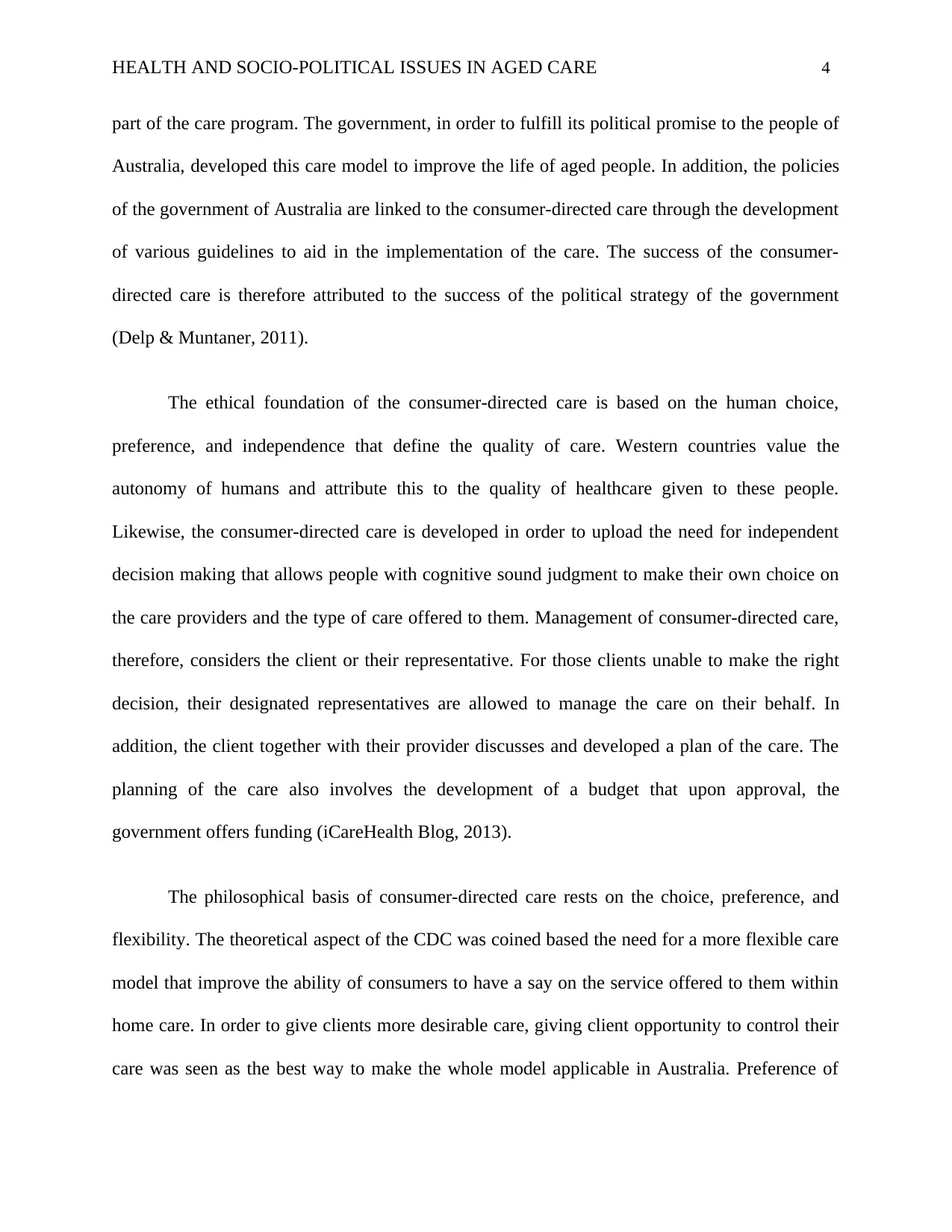
HEALTH AND SOCIO-POLITICAL ISSUES IN AGED CARE 4
part of the care program. The government, in order to fulfill its political promise to the people of
Australia, developed this care model to improve the life of aged people. In addition, the policies
of the government of Australia are linked to the consumer-directed care through the development
of various guidelines to aid in the implementation of the care. The success of the consumer-
directed care is therefore attributed to the success of the political strategy of the government
(Delp & Muntaner, 2011).
The ethical foundation of the consumer-directed care is based on the human choice,
preference, and independence that define the quality of care. Western countries value the
autonomy of humans and attribute this to the quality of healthcare given to these people.
Likewise, the consumer-directed care is developed in order to upload the need for independent
decision making that allows people with cognitive sound judgment to make their own choice on
the care providers and the type of care offered to them. Management of consumer-directed care,
therefore, considers the client or their representative. For those clients unable to make the right
decision, their designated representatives are allowed to manage the care on their behalf. In
addition, the client together with their provider discusses and developed a plan of the care. The
planning of the care also involves the development of a budget that upon approval, the
government offers funding (iCareHealth Blog, 2013).
The philosophical basis of consumer-directed care rests on the choice, preference, and
flexibility. The theoretical aspect of the CDC was coined based the need for a more flexible care
model that improve the ability of consumers to have a say on the service offered to them within
home care. In order to give clients more desirable care, giving client opportunity to control their
care was seen as the best way to make the whole model applicable in Australia. Preference of
part of the care program. The government, in order to fulfill its political promise to the people of
Australia, developed this care model to improve the life of aged people. In addition, the policies
of the government of Australia are linked to the consumer-directed care through the development
of various guidelines to aid in the implementation of the care. The success of the consumer-
directed care is therefore attributed to the success of the political strategy of the government
(Delp & Muntaner, 2011).
The ethical foundation of the consumer-directed care is based on the human choice,
preference, and independence that define the quality of care. Western countries value the
autonomy of humans and attribute this to the quality of healthcare given to these people.
Likewise, the consumer-directed care is developed in order to upload the need for independent
decision making that allows people with cognitive sound judgment to make their own choice on
the care providers and the type of care offered to them. Management of consumer-directed care,
therefore, considers the client or their representative. For those clients unable to make the right
decision, their designated representatives are allowed to manage the care on their behalf. In
addition, the client together with their provider discusses and developed a plan of the care. The
planning of the care also involves the development of a budget that upon approval, the
government offers funding (iCareHealth Blog, 2013).
The philosophical basis of consumer-directed care rests on the choice, preference, and
flexibility. The theoretical aspect of the CDC was coined based the need for a more flexible care
model that improve the ability of consumers to have a say on the service offered to them within
home care. In order to give clients more desirable care, giving client opportunity to control their
care was seen as the best way to make the whole model applicable in Australia. Preference of
Paraphrase This Document
Need a fresh take? Get an instant paraphrase of this document with our AI Paraphraser
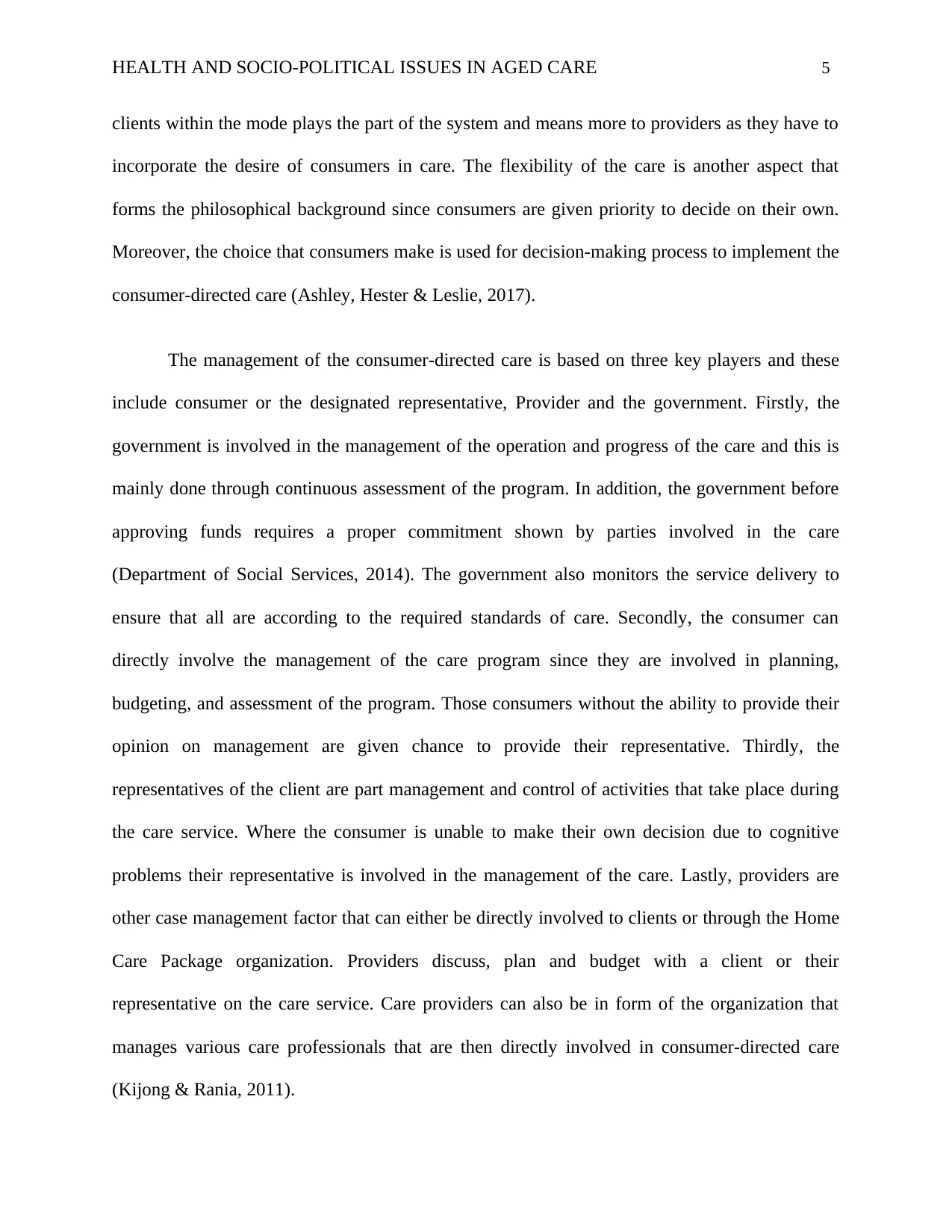
HEALTH AND SOCIO-POLITICAL ISSUES IN AGED CARE 5
clients within the mode plays the part of the system and means more to providers as they have to
incorporate the desire of consumers in care. The flexibility of the care is another aspect that
forms the philosophical background since consumers are given priority to decide on their own.
Moreover, the choice that consumers make is used for decision-making process to implement the
consumer-directed care (Ashley, Hester & Leslie, 2017).
The management of the consumer-directed care is based on three key players and these
include consumer or the designated representative, Provider and the government. Firstly, the
government is involved in the management of the operation and progress of the care and this is
mainly done through continuous assessment of the program. In addition, the government before
approving funds requires a proper commitment shown by parties involved in the care
(Department of Social Services, 2014). The government also monitors the service delivery to
ensure that all are according to the required standards of care. Secondly, the consumer can
directly involve the management of the care program since they are involved in planning,
budgeting, and assessment of the program. Those consumers without the ability to provide their
opinion on management are given chance to provide their representative. Thirdly, the
representatives of the client are part management and control of activities that take place during
the care service. Where the consumer is unable to make their own decision due to cognitive
problems their representative is involved in the management of the care. Lastly, providers are
other case management factor that can either be directly involved to clients or through the Home
Care Package organization. Providers discuss, plan and budget with a client or their
representative on the care service. Care providers can also be in form of the organization that
manages various care professionals that are then directly involved in consumer-directed care
(Kijong & Rania, 2011).
clients within the mode plays the part of the system and means more to providers as they have to
incorporate the desire of consumers in care. The flexibility of the care is another aspect that
forms the philosophical background since consumers are given priority to decide on their own.
Moreover, the choice that consumers make is used for decision-making process to implement the
consumer-directed care (Ashley, Hester & Leslie, 2017).
The management of the consumer-directed care is based on three key players and these
include consumer or the designated representative, Provider and the government. Firstly, the
government is involved in the management of the operation and progress of the care and this is
mainly done through continuous assessment of the program. In addition, the government before
approving funds requires a proper commitment shown by parties involved in the care
(Department of Social Services, 2014). The government also monitors the service delivery to
ensure that all are according to the required standards of care. Secondly, the consumer can
directly involve the management of the care program since they are involved in planning,
budgeting, and assessment of the program. Those consumers without the ability to provide their
opinion on management are given chance to provide their representative. Thirdly, the
representatives of the client are part management and control of activities that take place during
the care service. Where the consumer is unable to make their own decision due to cognitive
problems their representative is involved in the management of the care. Lastly, providers are
other case management factor that can either be directly involved to clients or through the Home
Care Package organization. Providers discuss, plan and budget with a client or their
representative on the care service. Care providers can also be in form of the organization that
manages various care professionals that are then directly involved in consumer-directed care
(Kijong & Rania, 2011).
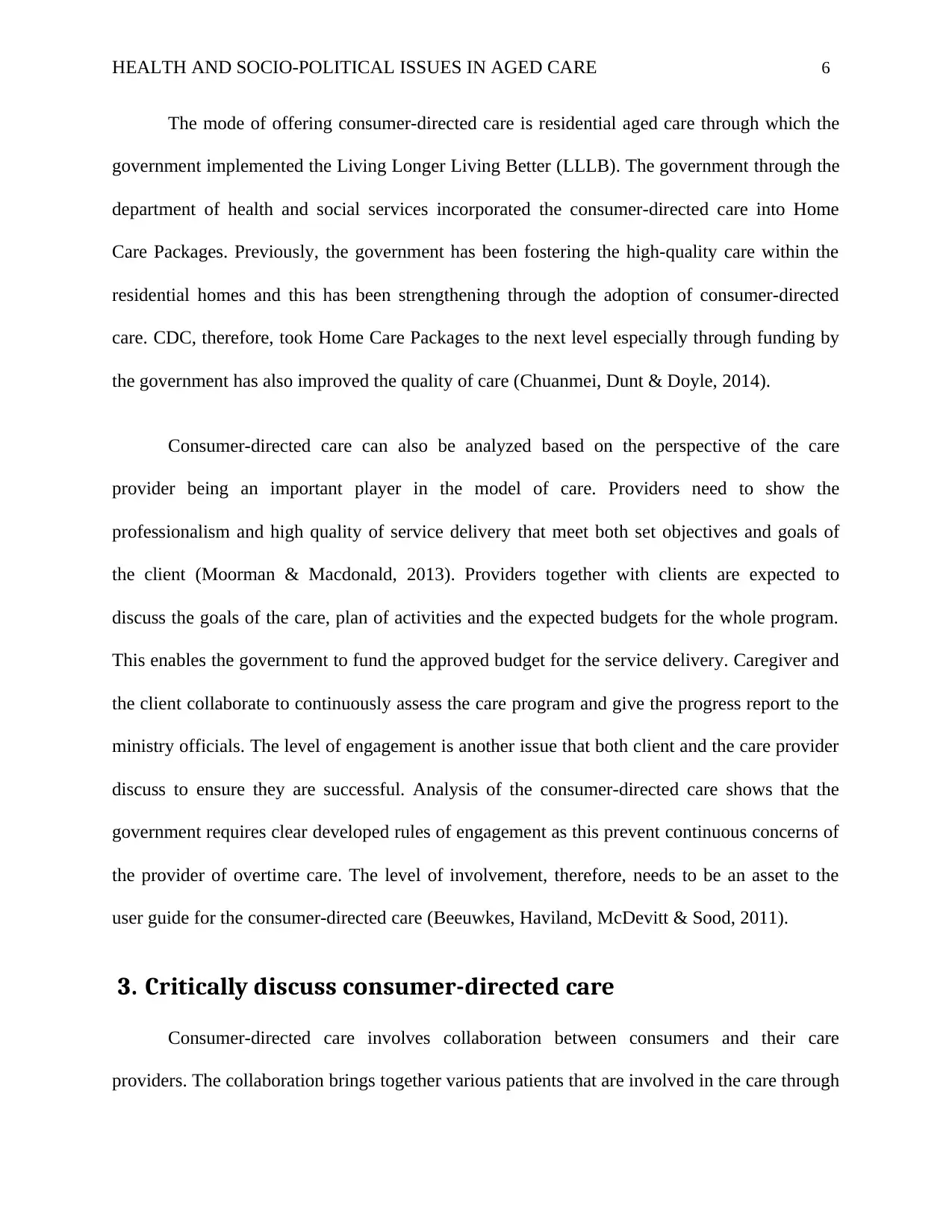
HEALTH AND SOCIO-POLITICAL ISSUES IN AGED CARE 6
The mode of offering consumer-directed care is residential aged care through which the
government implemented the Living Longer Living Better (LLLB). The government through the
department of health and social services incorporated the consumer-directed care into Home
Care Packages. Previously, the government has been fostering the high-quality care within the
residential homes and this has been strengthening through the adoption of consumer-directed
care. CDC, therefore, took Home Care Packages to the next level especially through funding by
the government has also improved the quality of care (Chuanmei, Dunt & Doyle, 2014).
Consumer-directed care can also be analyzed based on the perspective of the care
provider being an important player in the model of care. Providers need to show the
professionalism and high quality of service delivery that meet both set objectives and goals of
the client (Moorman & Macdonald, 2013). Providers together with clients are expected to
discuss the goals of the care, plan of activities and the expected budgets for the whole program.
This enables the government to fund the approved budget for the service delivery. Caregiver and
the client collaborate to continuously assess the care program and give the progress report to the
ministry officials. The level of engagement is another issue that both client and the care provider
discuss to ensure they are successful. Analysis of the consumer-directed care shows that the
government requires clear developed rules of engagement as this prevent continuous concerns of
the provider of overtime care. The level of involvement, therefore, needs to be an asset to the
user guide for the consumer-directed care (Beeuwkes, Haviland, McDevitt & Sood, 2011).
3. Critically discuss consumer-directed care
Consumer-directed care involves collaboration between consumers and their care
providers. The collaboration brings together various patients that are involved in the care through
The mode of offering consumer-directed care is residential aged care through which the
government implemented the Living Longer Living Better (LLLB). The government through the
department of health and social services incorporated the consumer-directed care into Home
Care Packages. Previously, the government has been fostering the high-quality care within the
residential homes and this has been strengthening through the adoption of consumer-directed
care. CDC, therefore, took Home Care Packages to the next level especially through funding by
the government has also improved the quality of care (Chuanmei, Dunt & Doyle, 2014).
Consumer-directed care can also be analyzed based on the perspective of the care
provider being an important player in the model of care. Providers need to show the
professionalism and high quality of service delivery that meet both set objectives and goals of
the client (Moorman & Macdonald, 2013). Providers together with clients are expected to
discuss the goals of the care, plan of activities and the expected budgets for the whole program.
This enables the government to fund the approved budget for the service delivery. Caregiver and
the client collaborate to continuously assess the care program and give the progress report to the
ministry officials. The level of engagement is another issue that both client and the care provider
discuss to ensure they are successful. Analysis of the consumer-directed care shows that the
government requires clear developed rules of engagement as this prevent continuous concerns of
the provider of overtime care. The level of involvement, therefore, needs to be an asset to the
user guide for the consumer-directed care (Beeuwkes, Haviland, McDevitt & Sood, 2011).
3. Critically discuss consumer-directed care
Consumer-directed care involves collaboration between consumers and their care
providers. The collaboration brings together various patients that are involved in the care through
⊘ This is a preview!⊘
Do you want full access?
Subscribe today to unlock all pages.

Trusted by 1+ million students worldwide
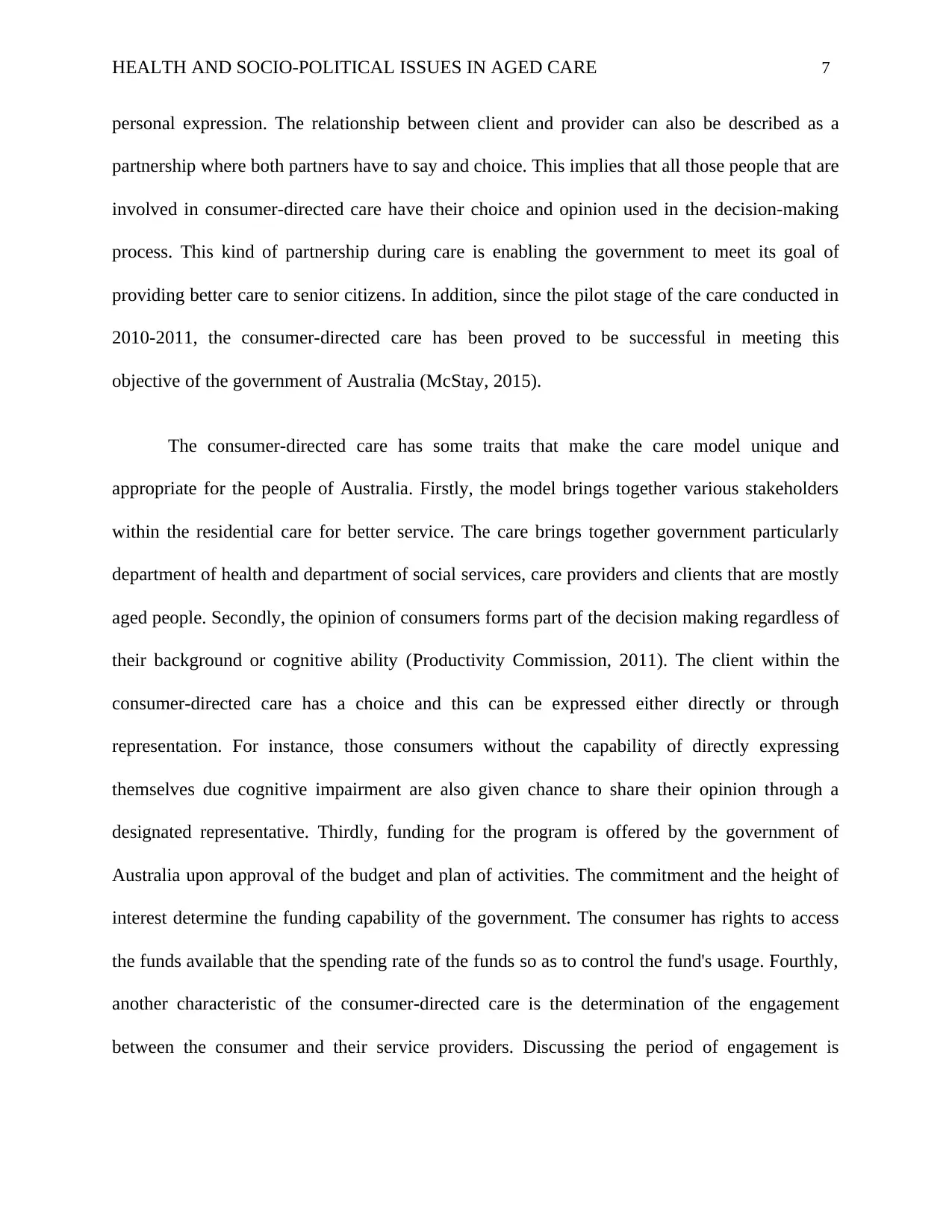
HEALTH AND SOCIO-POLITICAL ISSUES IN AGED CARE 7
personal expression. The relationship between client and provider can also be described as a
partnership where both partners have to say and choice. This implies that all those people that are
involved in consumer-directed care have their choice and opinion used in the decision-making
process. This kind of partnership during care is enabling the government to meet its goal of
providing better care to senior citizens. In addition, since the pilot stage of the care conducted in
2010-2011, the consumer-directed care has been proved to be successful in meeting this
objective of the government of Australia (McStay, 2015).
The consumer-directed care has some traits that make the care model unique and
appropriate for the people of Australia. Firstly, the model brings together various stakeholders
within the residential care for better service. The care brings together government particularly
department of health and department of social services, care providers and clients that are mostly
aged people. Secondly, the opinion of consumers forms part of the decision making regardless of
their background or cognitive ability (Productivity Commission, 2011). The client within the
consumer-directed care has a choice and this can be expressed either directly or through
representation. For instance, those consumers without the capability of directly expressing
themselves due cognitive impairment are also given chance to share their opinion through a
designated representative. Thirdly, funding for the program is offered by the government of
Australia upon approval of the budget and plan of activities. The commitment and the height of
interest determine the funding capability of the government. The consumer has rights to access
the funds available that the spending rate of the funds so as to control the fund's usage. Fourthly,
another characteristic of the consumer-directed care is the determination of the engagement
between the consumer and their service providers. Discussing the period of engagement is
personal expression. The relationship between client and provider can also be described as a
partnership where both partners have to say and choice. This implies that all those people that are
involved in consumer-directed care have their choice and opinion used in the decision-making
process. This kind of partnership during care is enabling the government to meet its goal of
providing better care to senior citizens. In addition, since the pilot stage of the care conducted in
2010-2011, the consumer-directed care has been proved to be successful in meeting this
objective of the government of Australia (McStay, 2015).
The consumer-directed care has some traits that make the care model unique and
appropriate for the people of Australia. Firstly, the model brings together various stakeholders
within the residential care for better service. The care brings together government particularly
department of health and department of social services, care providers and clients that are mostly
aged people. Secondly, the opinion of consumers forms part of the decision making regardless of
their background or cognitive ability (Productivity Commission, 2011). The client within the
consumer-directed care has a choice and this can be expressed either directly or through
representation. For instance, those consumers without the capability of directly expressing
themselves due cognitive impairment are also given chance to share their opinion through a
designated representative. Thirdly, funding for the program is offered by the government of
Australia upon approval of the budget and plan of activities. The commitment and the height of
interest determine the funding capability of the government. The consumer has rights to access
the funds available that the spending rate of the funds so as to control the fund's usage. Fourthly,
another characteristic of the consumer-directed care is the determination of the engagement
between the consumer and their service providers. Discussing the period of engagement is
Paraphrase This Document
Need a fresh take? Get an instant paraphrase of this document with our AI Paraphraser
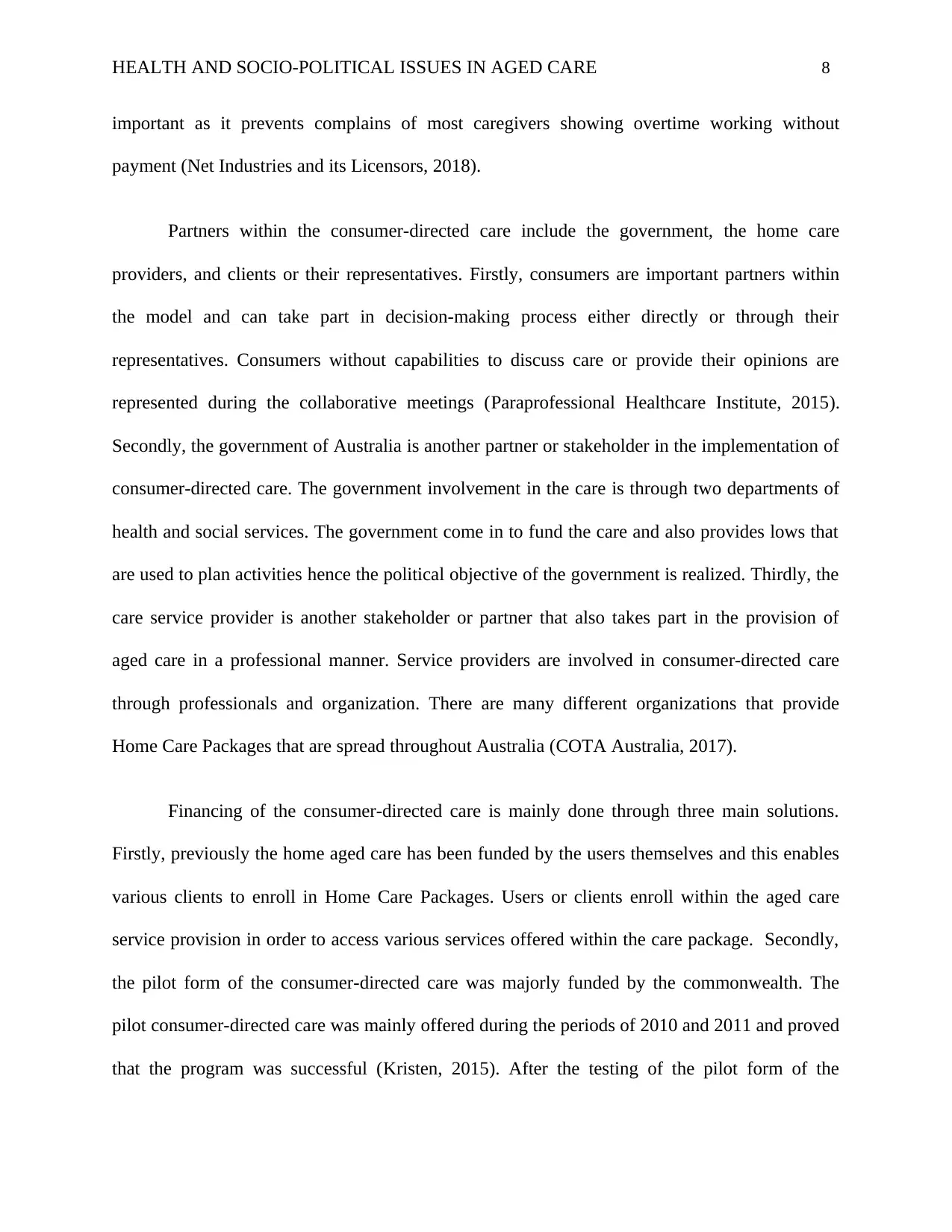
HEALTH AND SOCIO-POLITICAL ISSUES IN AGED CARE 8
important as it prevents complains of most caregivers showing overtime working without
payment (Net Industries and its Licensors, 2018).
Partners within the consumer-directed care include the government, the home care
providers, and clients or their representatives. Firstly, consumers are important partners within
the model and can take part in decision-making process either directly or through their
representatives. Consumers without capabilities to discuss care or provide their opinions are
represented during the collaborative meetings (Paraprofessional Healthcare Institute, 2015).
Secondly, the government of Australia is another partner or stakeholder in the implementation of
consumer-directed care. The government involvement in the care is through two departments of
health and social services. The government come in to fund the care and also provides lows that
are used to plan activities hence the political objective of the government is realized. Thirdly, the
care service provider is another stakeholder or partner that also takes part in the provision of
aged care in a professional manner. Service providers are involved in consumer-directed care
through professionals and organization. There are many different organizations that provide
Home Care Packages that are spread throughout Australia (COTA Australia, 2017).
Financing of the consumer-directed care is mainly done through three main solutions.
Firstly, previously the home aged care has been funded by the users themselves and this enables
various clients to enroll in Home Care Packages. Users or clients enroll within the aged care
service provision in order to access various services offered within the care package. Secondly,
the pilot form of the consumer-directed care was majorly funded by the commonwealth. The
pilot consumer-directed care was mainly offered during the periods of 2010 and 2011 and proved
that the program was successful (Kristen, 2015). After the testing of the pilot form of the
important as it prevents complains of most caregivers showing overtime working without
payment (Net Industries and its Licensors, 2018).
Partners within the consumer-directed care include the government, the home care
providers, and clients or their representatives. Firstly, consumers are important partners within
the model and can take part in decision-making process either directly or through their
representatives. Consumers without capabilities to discuss care or provide their opinions are
represented during the collaborative meetings (Paraprofessional Healthcare Institute, 2015).
Secondly, the government of Australia is another partner or stakeholder in the implementation of
consumer-directed care. The government involvement in the care is through two departments of
health and social services. The government come in to fund the care and also provides lows that
are used to plan activities hence the political objective of the government is realized. Thirdly, the
care service provider is another stakeholder or partner that also takes part in the provision of
aged care in a professional manner. Service providers are involved in consumer-directed care
through professionals and organization. There are many different organizations that provide
Home Care Packages that are spread throughout Australia (COTA Australia, 2017).
Financing of the consumer-directed care is mainly done through three main solutions.
Firstly, previously the home aged care has been funded by the users themselves and this enables
various clients to enroll in Home Care Packages. Users or clients enroll within the aged care
service provision in order to access various services offered within the care package. Secondly,
the pilot form of the consumer-directed care was majorly funded by the commonwealth. The
pilot consumer-directed care was mainly offered during the periods of 2010 and 2011 and proved
that the program was successful (Kristen, 2015). After the testing of the pilot form of the
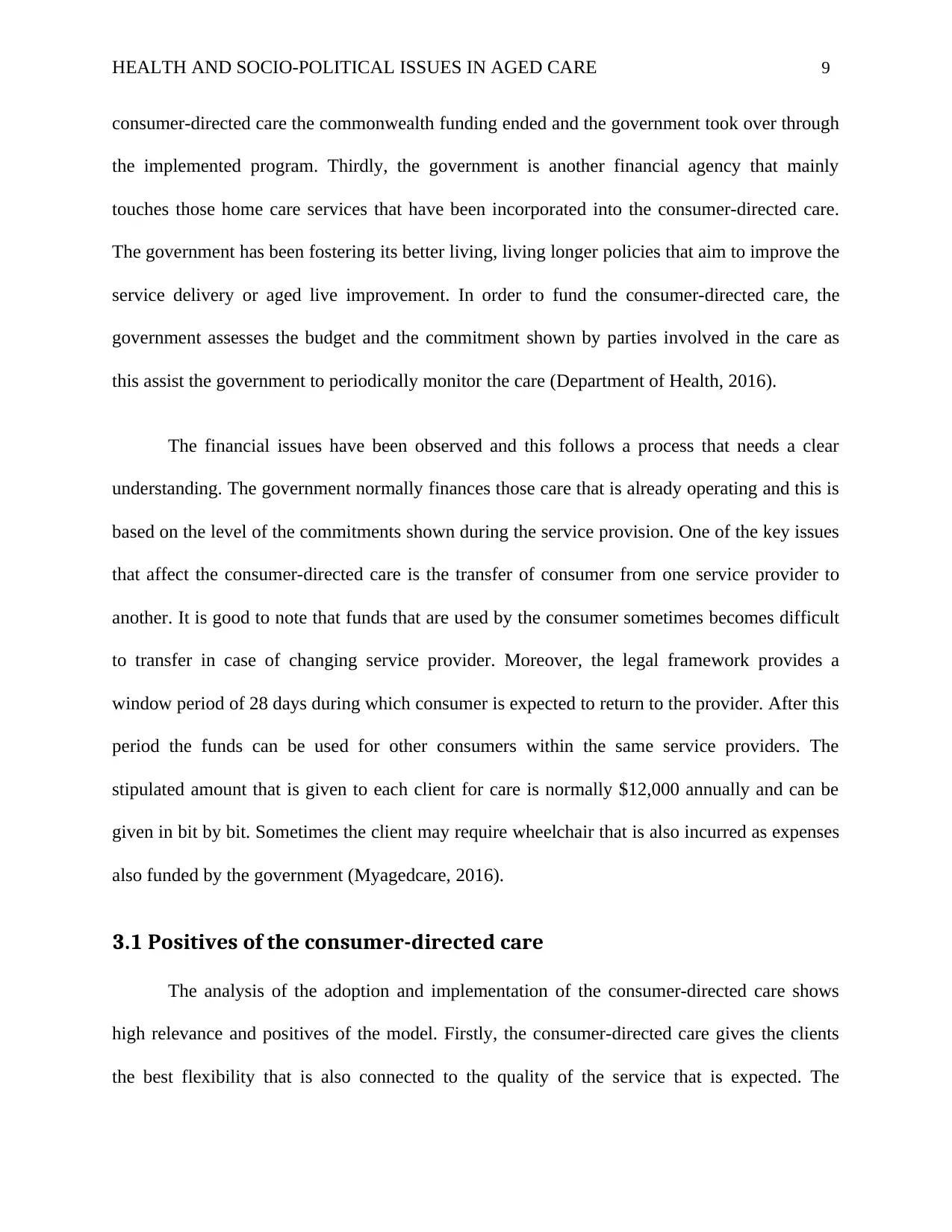
HEALTH AND SOCIO-POLITICAL ISSUES IN AGED CARE 9
consumer-directed care the commonwealth funding ended and the government took over through
the implemented program. Thirdly, the government is another financial agency that mainly
touches those home care services that have been incorporated into the consumer-directed care.
The government has been fostering its better living, living longer policies that aim to improve the
service delivery or aged live improvement. In order to fund the consumer-directed care, the
government assesses the budget and the commitment shown by parties involved in the care as
this assist the government to periodically monitor the care (Department of Health, 2016).
The financial issues have been observed and this follows a process that needs a clear
understanding. The government normally finances those care that is already operating and this is
based on the level of the commitments shown during the service provision. One of the key issues
that affect the consumer-directed care is the transfer of consumer from one service provider to
another. It is good to note that funds that are used by the consumer sometimes becomes difficult
to transfer in case of changing service provider. Moreover, the legal framework provides a
window period of 28 days during which consumer is expected to return to the provider. After this
period the funds can be used for other consumers within the same service providers. The
stipulated amount that is given to each client for care is normally $12,000 annually and can be
given in bit by bit. Sometimes the client may require wheelchair that is also incurred as expenses
also funded by the government (Myagedcare, 2016).
3.1 Positives of the consumer-directed care
The analysis of the adoption and implementation of the consumer-directed care shows
high relevance and positives of the model. Firstly, the consumer-directed care gives the clients
the best flexibility that is also connected to the quality of the service that is expected. The
consumer-directed care the commonwealth funding ended and the government took over through
the implemented program. Thirdly, the government is another financial agency that mainly
touches those home care services that have been incorporated into the consumer-directed care.
The government has been fostering its better living, living longer policies that aim to improve the
service delivery or aged live improvement. In order to fund the consumer-directed care, the
government assesses the budget and the commitment shown by parties involved in the care as
this assist the government to periodically monitor the care (Department of Health, 2016).
The financial issues have been observed and this follows a process that needs a clear
understanding. The government normally finances those care that is already operating and this is
based on the level of the commitments shown during the service provision. One of the key issues
that affect the consumer-directed care is the transfer of consumer from one service provider to
another. It is good to note that funds that are used by the consumer sometimes becomes difficult
to transfer in case of changing service provider. Moreover, the legal framework provides a
window period of 28 days during which consumer is expected to return to the provider. After this
period the funds can be used for other consumers within the same service providers. The
stipulated amount that is given to each client for care is normally $12,000 annually and can be
given in bit by bit. Sometimes the client may require wheelchair that is also incurred as expenses
also funded by the government (Myagedcare, 2016).
3.1 Positives of the consumer-directed care
The analysis of the adoption and implementation of the consumer-directed care shows
high relevance and positives of the model. Firstly, the consumer-directed care gives the clients
the best flexibility that is also connected to the quality of the service that is expected. The
⊘ This is a preview!⊘
Do you want full access?
Subscribe today to unlock all pages.

Trusted by 1+ million students worldwide
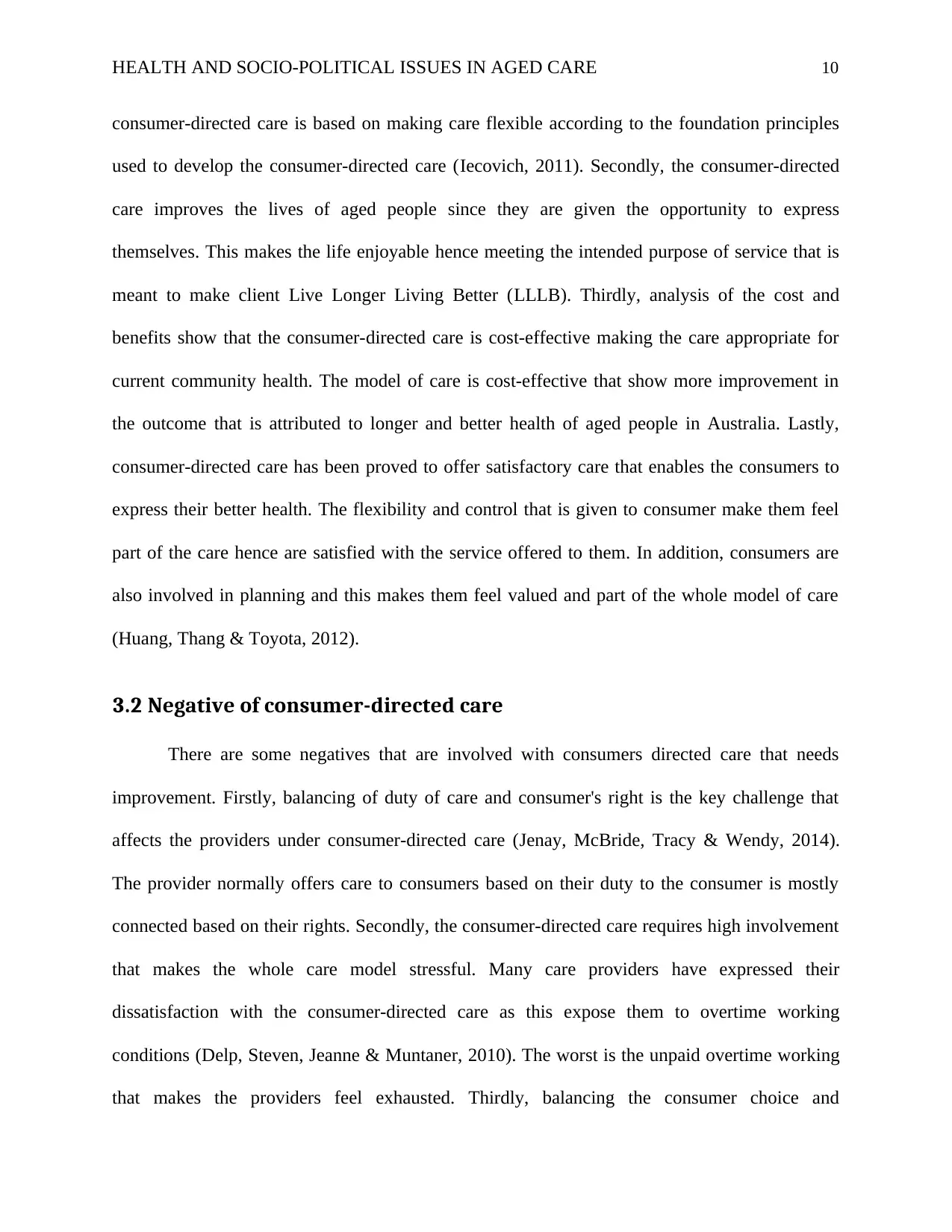
HEALTH AND SOCIO-POLITICAL ISSUES IN AGED CARE 10
consumer-directed care is based on making care flexible according to the foundation principles
used to develop the consumer-directed care (Iecovich, 2011). Secondly, the consumer-directed
care improves the lives of aged people since they are given the opportunity to express
themselves. This makes the life enjoyable hence meeting the intended purpose of service that is
meant to make client Live Longer Living Better (LLLB). Thirdly, analysis of the cost and
benefits show that the consumer-directed care is cost-effective making the care appropriate for
current community health. The model of care is cost-effective that show more improvement in
the outcome that is attributed to longer and better health of aged people in Australia. Lastly,
consumer-directed care has been proved to offer satisfactory care that enables the consumers to
express their better health. The flexibility and control that is given to consumer make them feel
part of the care hence are satisfied with the service offered to them. In addition, consumers are
also involved in planning and this makes them feel valued and part of the whole model of care
(Huang, Thang & Toyota, 2012).
3.2 Negative of consumer-directed care
There are some negatives that are involved with consumers directed care that needs
improvement. Firstly, balancing of duty of care and consumer's right is the key challenge that
affects the providers under consumer-directed care (Jenay, McBride, Tracy & Wendy, 2014).
The provider normally offers care to consumers based on their duty to the consumer is mostly
connected based on their rights. Secondly, the consumer-directed care requires high involvement
that makes the whole care model stressful. Many care providers have expressed their
dissatisfaction with the consumer-directed care as this expose them to overtime working
conditions (Delp, Steven, Jeanne & Muntaner, 2010). The worst is the unpaid overtime working
that makes the providers feel exhausted. Thirdly, balancing the consumer choice and
consumer-directed care is based on making care flexible according to the foundation principles
used to develop the consumer-directed care (Iecovich, 2011). Secondly, the consumer-directed
care improves the lives of aged people since they are given the opportunity to express
themselves. This makes the life enjoyable hence meeting the intended purpose of service that is
meant to make client Live Longer Living Better (LLLB). Thirdly, analysis of the cost and
benefits show that the consumer-directed care is cost-effective making the care appropriate for
current community health. The model of care is cost-effective that show more improvement in
the outcome that is attributed to longer and better health of aged people in Australia. Lastly,
consumer-directed care has been proved to offer satisfactory care that enables the consumers to
express their better health. The flexibility and control that is given to consumer make them feel
part of the care hence are satisfied with the service offered to them. In addition, consumers are
also involved in planning and this makes them feel valued and part of the whole model of care
(Huang, Thang & Toyota, 2012).
3.2 Negative of consumer-directed care
There are some negatives that are involved with consumers directed care that needs
improvement. Firstly, balancing of duty of care and consumer's right is the key challenge that
affects the providers under consumer-directed care (Jenay, McBride, Tracy & Wendy, 2014).
The provider normally offers care to consumers based on their duty to the consumer is mostly
connected based on their rights. Secondly, the consumer-directed care requires high involvement
that makes the whole care model stressful. Many care providers have expressed their
dissatisfaction with the consumer-directed care as this expose them to overtime working
conditions (Delp, Steven, Jeanne & Muntaner, 2010). The worst is the unpaid overtime working
that makes the providers feel exhausted. Thirdly, balancing the consumer choice and
Paraphrase This Document
Need a fresh take? Get an instant paraphrase of this document with our AI Paraphraser
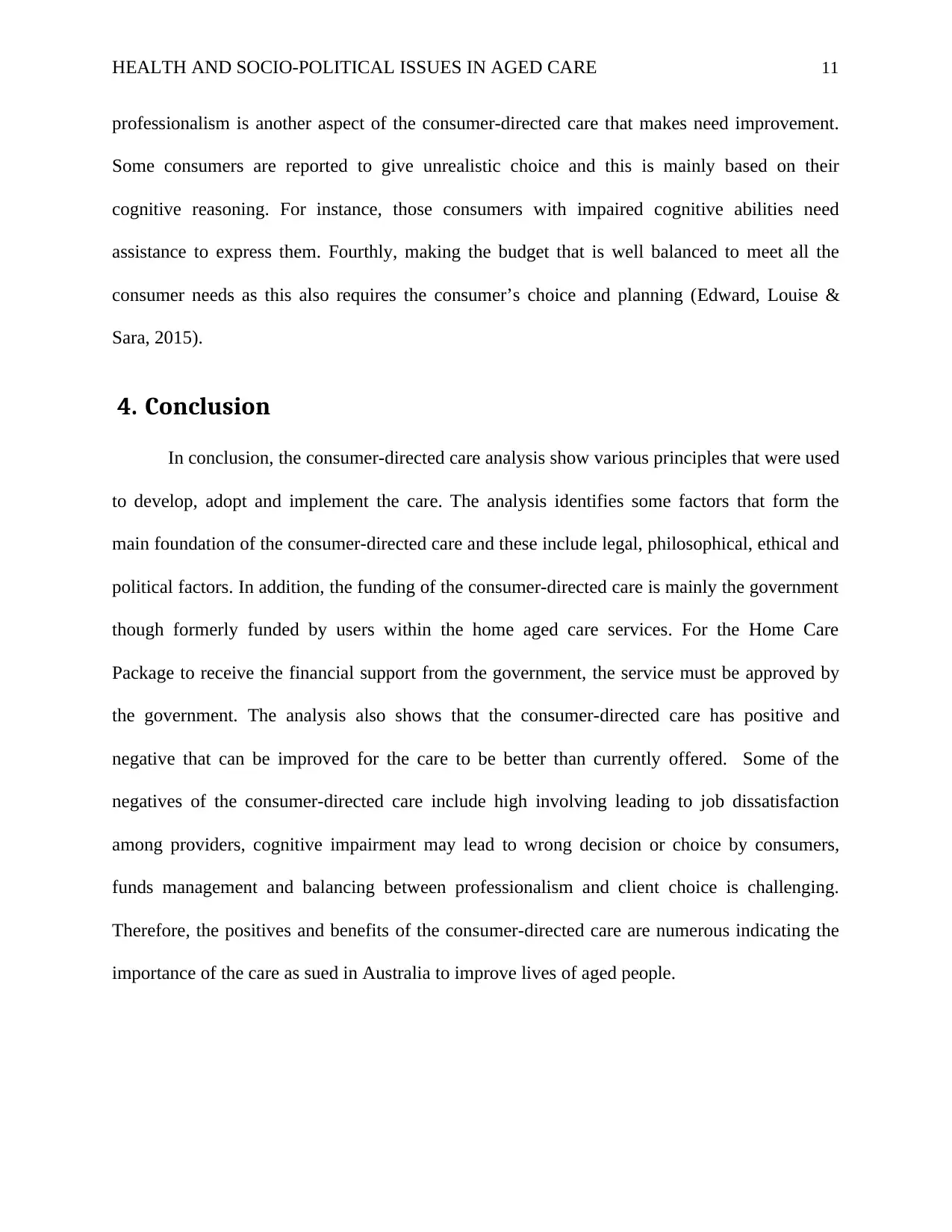
HEALTH AND SOCIO-POLITICAL ISSUES IN AGED CARE 11
professionalism is another aspect of the consumer-directed care that makes need improvement.
Some consumers are reported to give unrealistic choice and this is mainly based on their
cognitive reasoning. For instance, those consumers with impaired cognitive abilities need
assistance to express them. Fourthly, making the budget that is well balanced to meet all the
consumer needs as this also requires the consumer’s choice and planning (Edward, Louise &
Sara, 2015).
4. Conclusion
In conclusion, the consumer-directed care analysis show various principles that were used
to develop, adopt and implement the care. The analysis identifies some factors that form the
main foundation of the consumer-directed care and these include legal, philosophical, ethical and
political factors. In addition, the funding of the consumer-directed care is mainly the government
though formerly funded by users within the home aged care services. For the Home Care
Package to receive the financial support from the government, the service must be approved by
the government. The analysis also shows that the consumer-directed care has positive and
negative that can be improved for the care to be better than currently offered. Some of the
negatives of the consumer-directed care include high involving leading to job dissatisfaction
among providers, cognitive impairment may lead to wrong decision or choice by consumers,
funds management and balancing between professionalism and client choice is challenging.
Therefore, the positives and benefits of the consumer-directed care are numerous indicating the
importance of the care as sued in Australia to improve lives of aged people.
professionalism is another aspect of the consumer-directed care that makes need improvement.
Some consumers are reported to give unrealistic choice and this is mainly based on their
cognitive reasoning. For instance, those consumers with impaired cognitive abilities need
assistance to express them. Fourthly, making the budget that is well balanced to meet all the
consumer needs as this also requires the consumer’s choice and planning (Edward, Louise &
Sara, 2015).
4. Conclusion
In conclusion, the consumer-directed care analysis show various principles that were used
to develop, adopt and implement the care. The analysis identifies some factors that form the
main foundation of the consumer-directed care and these include legal, philosophical, ethical and
political factors. In addition, the funding of the consumer-directed care is mainly the government
though formerly funded by users within the home aged care services. For the Home Care
Package to receive the financial support from the government, the service must be approved by
the government. The analysis also shows that the consumer-directed care has positive and
negative that can be improved for the care to be better than currently offered. Some of the
negatives of the consumer-directed care include high involving leading to job dissatisfaction
among providers, cognitive impairment may lead to wrong decision or choice by consumers,
funds management and balancing between professionalism and client choice is challenging.
Therefore, the positives and benefits of the consumer-directed care are numerous indicating the
importance of the care as sued in Australia to improve lives of aged people.
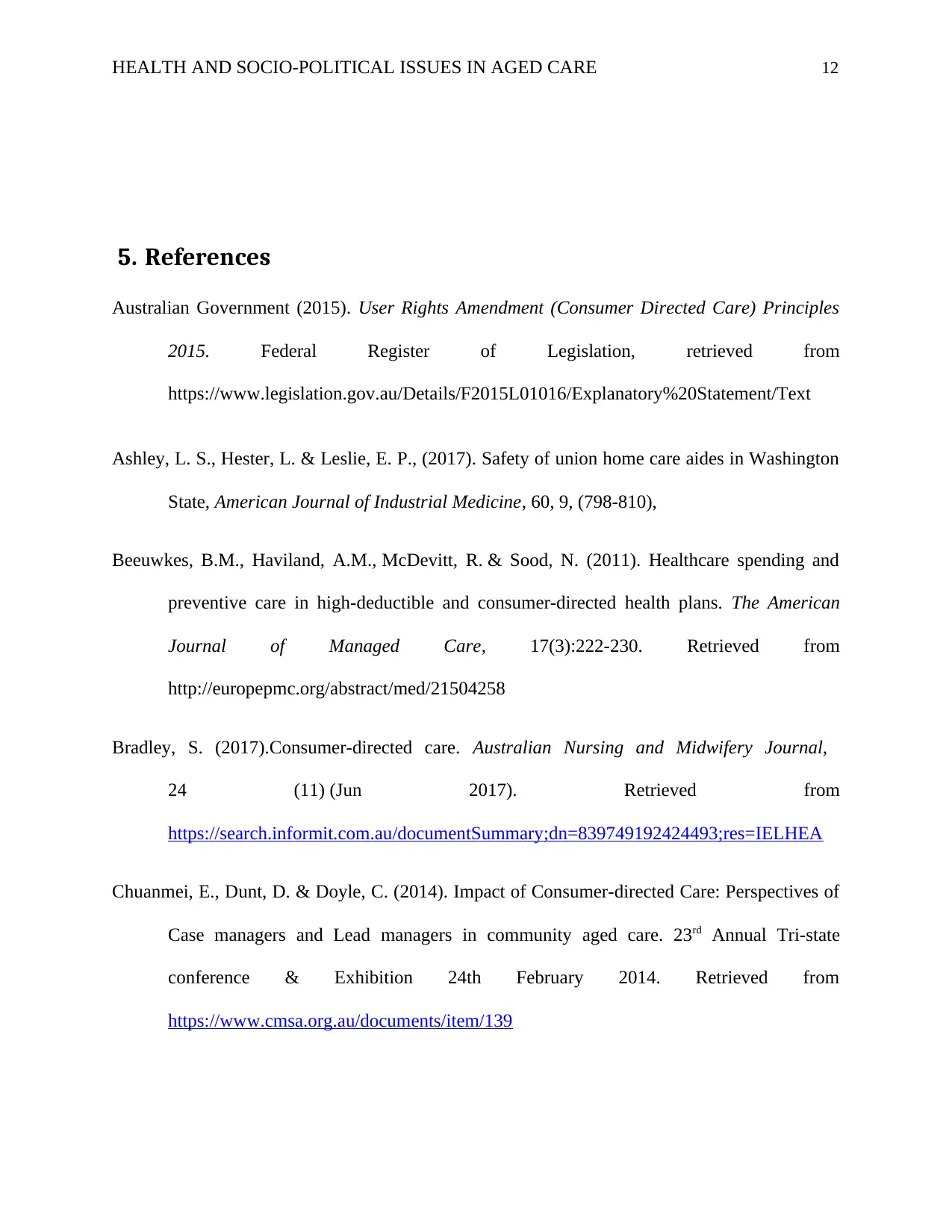
HEALTH AND SOCIO-POLITICAL ISSUES IN AGED CARE 12
5. References
Australian Government (2015). User Rights Amendment (Consumer Directed Care) Principles
2015. Federal Register of Legislation, retrieved from
https://www.legislation.gov.au/Details/F2015L01016/Explanatory%20Statement/Text
Ashley, L. S., Hester, L. & Leslie, E. P., (2017). Safety of union home care aides in Washington
State, American Journal of Industrial Medicine, 60, 9, (798-810),
Beeuwkes, B.M., Haviland, A.M., McDevitt, R. & Sood, N. (2011). Healthcare spending and
preventive care in high-deductible and consumer-directed health plans. The American
Journal of Managed Care, 17(3):222-230. Retrieved from
http://europepmc.org/abstract/med/21504258
Bradley, S. (2017).Consumer-directed care. Australian Nursing and Midwifery Journal,
24 (11) (Jun 2017). Retrieved from
https://search.informit.com.au/documentSummary;dn=839749192424493;res=IELHEA
Chuanmei, E., Dunt, D. & Doyle, C. (2014). Impact of Consumer-directed Care: Perspectives of
Case managers and Lead managers in community aged care. 23rd Annual Tri-state
conference & Exhibition 24th February 2014. Retrieved from
https://www.cmsa.org.au/documents/item/139
5. References
Australian Government (2015). User Rights Amendment (Consumer Directed Care) Principles
2015. Federal Register of Legislation, retrieved from
https://www.legislation.gov.au/Details/F2015L01016/Explanatory%20Statement/Text
Ashley, L. S., Hester, L. & Leslie, E. P., (2017). Safety of union home care aides in Washington
State, American Journal of Industrial Medicine, 60, 9, (798-810),
Beeuwkes, B.M., Haviland, A.M., McDevitt, R. & Sood, N. (2011). Healthcare spending and
preventive care in high-deductible and consumer-directed health plans. The American
Journal of Managed Care, 17(3):222-230. Retrieved from
http://europepmc.org/abstract/med/21504258
Bradley, S. (2017).Consumer-directed care. Australian Nursing and Midwifery Journal,
24 (11) (Jun 2017). Retrieved from
https://search.informit.com.au/documentSummary;dn=839749192424493;res=IELHEA
Chuanmei, E., Dunt, D. & Doyle, C. (2014). Impact of Consumer-directed Care: Perspectives of
Case managers and Lead managers in community aged care. 23rd Annual Tri-state
conference & Exhibition 24th February 2014. Retrieved from
https://www.cmsa.org.au/documents/item/139
⊘ This is a preview!⊘
Do you want full access?
Subscribe today to unlock all pages.

Trusted by 1+ million students worldwide
1 out of 16
Related Documents
Your All-in-One AI-Powered Toolkit for Academic Success.
+13062052269
info@desklib.com
Available 24*7 on WhatsApp / Email
![[object Object]](/_next/static/media/star-bottom.7253800d.svg)
Unlock your academic potential
Copyright © 2020–2025 A2Z Services. All Rights Reserved. Developed and managed by ZUCOL.


